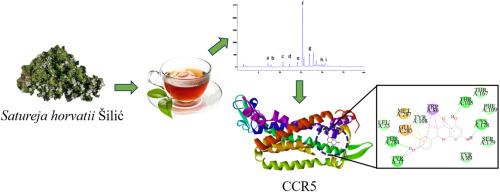木香树Šilić, Lamiaceae提取物的生化分析:实验和分子对接方面
IF 3.8
Q2 BIOTECHNOLOGY & APPLIED MICROBIOLOGY
引用次数: 0
摘要
Satureja horvatii Šilić是巴尔干半岛的一种特有物种,传统上用于许多混合茶,但尚未充分探索。本研究旨在从其酚类成分、抗氧化活性和抗hiv潜能等方面对该植物的乙醇提取物和草药浸剂进行评价。采用分光光度法测定中药饮片和70% (v/v)乙醇提取物的总酚和总黄酮含量,并采用高压液相色谱-二极管阵列检测(HPLC-DAD)进行详细的化学表征。通过对2,2-二苯基-1-苦味酰肼(DPPH)自由基的中和能力来评价其抗氧化活性。通过分子对接检测化合物对CCR5型半胱氨酸-半胱氨酸趋化因子受体的抗病毒潜力。主要活性成分为芦丁(30.90 ~ 69.40 mg/g)、迷迭香(13.10 ~ 45.30 mg/g)和对香豆酸(14 ~ 35.50 mg/g)。提取物具有明显的DPPH自由基清除能力(IC50值为4.63 ~ 9.94 μg/mL)。在分子对接研究中,类黄酮衍生物-柚皮素、表儿茶素、槲皮素;酚酸中的绿原酸与CCR5具有较高的结合亲和力,并与靶受体活性位点的关键残基相互作用。荆芥提取物具有良好的抗病毒潜力,值得进一步研究发现新的抗hiv治疗方法。本文章由计算机程序翻译,如有差异,请以英文原文为准。

Biochemical profiling of Satureja horvatii Šilić, Lamiaceae extracts: Experimental and molecular docking aspects
Satureja horvatii Šilić is an endemic species of the Balkan Peninsula traditionally used in many tea blends, yet insufficiently explored. This study aimed to evaluate the ethanol extracts and herbal infusion of this species in terms of phenolic composition, antioxidant activity, and anti-HIV potential of its constituents. The total phenolic and flavonoid content of herbal infusion and 70 % (v/v) ethanol extracts was determined spectrophotometrically, while detailed chemical characterization by high pressure liquid chromatography coupled with diode array detection (HPLC-DAD). Antioxidant activity was evaluated by the ability of extracts to neutralize 2,2-diphenyl-1-picrylhydrazyl (DPPH) radical. The antiviral potential of compounds was tested against cysteine-cysteine chemokine receptor type 5 (CCR5) by molecular docking. The major bioactive components of the extracts were rutin (30.90–69.40 mg/g dry extract (de)), rosmarinic (13.10–45.30 mg/g de), and p-coumaric acid (14–35.50 mg/g de). The extracts exhibited significant DPPH radical scavenging potential (IC50 values ranging from 4.63 to 9.94 μg/mL). In the molecular docking study, flavonoid derivates – naringenin, epicatechin, quercetin; and chlorogenic acid among the phenolic acids had a high binding affinity toward CCR5 and interacted with key residues at the active site of the target receptor. S. horvatii extracts show promising antiviral potential and are worthy of further research in discovering novel anti-HIV therapy.
求助全文
通过发布文献求助,成功后即可免费获取论文全文。
去求助
来源期刊

Biocatalysis and agricultural biotechnology
Agricultural and Biological Sciences-Agronomy and Crop Science
CiteScore
7.70
自引率
2.50%
发文量
308
审稿时长
48 days
期刊介绍:
Biocatalysis and Agricultural Biotechnology is the official journal of the International Society of Biocatalysis and Agricultural Biotechnology (ISBAB). The journal publishes high quality articles especially in the science and technology of biocatalysis, bioprocesses, agricultural biotechnology, biomedical biotechnology, and, if appropriate, from other related areas of biotechnology. The journal will publish peer-reviewed basic and applied research papers, authoritative reviews, and feature articles. The scope of the journal encompasses the research, industrial, and commercial aspects of biotechnology, including the areas of: biocatalysis; bioprocesses; food and agriculture; genetic engineering; molecular biology; healthcare and pharmaceuticals; biofuels; genomics; nanotechnology; environment and biodiversity; and bioremediation.
 求助内容:
求助内容: 应助结果提醒方式:
应助结果提醒方式:


